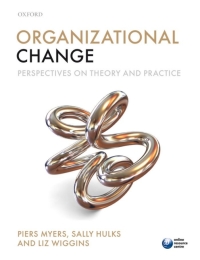Her Majestys Revenue and Customs (HMRC) is a department of British government, responsible for the collection of
Question:
Her Majesty’s Revenue and Customs (HMRC) is a department of British government, responsible for the collection of taxes and the detection and prevention of smuggling. It was formed in 2005 by the merger o f the Inland Revenue (Revenue) and Her Majesty’s Customs and Excise (Customs). The two departments had very different histories, cultures, and legal powers. The joint organization employed some 80,000 people. It was expected that 12,500 jobs would be lost as a result of the merger by 2008, with further job losses to result from the closure of smaller local tax offi ces.
Against this backdrop, HMRC declared that the level of service to its customers would be increased by the implementation of Lean process reviews alongside the introduction of new technology and stronger focus on the needs of the taxpayer. It planned to spend £2.7 billion in the period 2007–11 on a transformation programme with the aim of becoming the UK government’s processor of choice, to:
● redesign service delivery processes;
● implement the appropriate management infrastructure;
● change thinking and behaviour in staff to support the new approach.
The application of Lean within HMRC was known as the Pacesetter programme. Pacesetter embraced Lean, along with development in leadership, with the aim of achieving a top-down and bottom-up approach to improving performance: ‘Lean drives performances up in to the wider organisation. [Operational management and senior leadership] drive performance from the leadership team down in to the wider organization’ (Radnor and Bucci, 2007: 3). When Lean programmes were fi rst introduced, the organization was still in the aftermath of its merger. Staff were preoccupied with grading issues resulting from the combining of two different structures, with proposed offi ce closures, and grappling with the instigation of a raft of new roles, such as the customer relationship manager, whose purpose was to offer one face to the customer, thereby straddling Revenue and Customs. Lean was one more change. Stories of clear desk policies, of not being allowed any personal possessions, and of depersonalized ways of working spread rapidly when Lean was fi rst applied. Despite this, HMRC aimed to use
‘Pacesetter’ to motivate and empower staff. It hoped to integrate reviews of processes with cultural and behavioural changes, to ensure the ongoing sustainability of Lean.
Alongside Lean, the key IT programmes were managed centrally, focusing on large systems data storage changes. It was decided to implement Lean locally in strategic HMRC sites, which would incorporate the work of smaller sites over time, using Lean as the way of working. To implement Lean across these sites, a number of dedicated central and local experts were based in the offi ces.
Lean was introduced by a series of workshops, helping people to understand the possibilities for performance improvement and encouraging their input to the changes.
In 2007, an evaluation of Lean was undertaken by A to Z business consultancy, assisted by Warwick Business School, which found the following.
● There was a direct correlation between senior management engagement and staff attitude towards Lean: the more committed the senior team, the more positive the attitude towards Lean.
● Lean resulted in an increase in the quality of work at all sites. This was partly to do with quality checks being instigated, so errors were caught before the work left the team. They noted that, in time, there was a need for front-line staff to become directly responsible for quality.
● Lean created more reasons for front-line staff to speak to managers, which was welcomed by many staff. The evaluation recommended supporting this shift with training to meet the new needs of the roles.
● Senior managers had a better understanding of Lean than front-line staff, for whom perceptions were infl uenced by union documentation. The evaluation suggested better handling of communications to overcome this.
● Some of the new key performance indicators (KPIs), under which individual productivity was recorded hourly and then aggregated to team productivity, worried staff and the reasons for having such indicators were not understood. Despite this, overall team working was acknowledged to be better under Lean, with better team spirit and problem-solving.
Lean continued to be implemented successfully in further areas and, from 2008, HMRC claimed the best ever quality improvements in processing, with improvements in customer service and productivity increases of at least 30 per cent in areas in which Pacesetter was operational. As a result, HMRC remained committed to continuing to update its IT systems, to working with Lean, and to continuing to strive for the culture change that it desired.
Questions Consider the size of the HMRC organization, and the scale and span of the change that it wants to achieve.
1. In light of the context described here, what style of management do you think was needed to make the changes for which HMRC hoped?
2. What part does Lean play in effecting change at HMRC?
3. What are its limitations and why?
Step by Step Answer:

Organizational Change Perspectives On Theory And Practice
ISBN: 9780199573783,9780191512902
1st Edition
Authors: Piers Myers; Sally Hulks; Liz Wiggins





